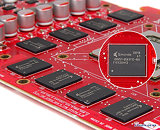- Joined
- Oct 9, 2007
- Messages
- 47,244 (7.54/day)
- Location
- Hyderabad, India
| System Name | RBMK-1000 |
|---|---|
| Processor | AMD Ryzen 7 5700G |
| Motherboard | ASUS ROG Strix B450-E Gaming |
| Cooling | DeepCool Gammax L240 V2 |
| Memory | 2x 8GB G.Skill Sniper X |
| Video Card(s) | Palit GeForce RTX 2080 SUPER GameRock |
| Storage | Western Digital Black NVMe 512GB |
| Display(s) | BenQ 1440p 60 Hz 27-inch |
| Case | Corsair Carbide 100R |
| Audio Device(s) | ASUS SupremeFX S1220A |
| Power Supply | Cooler Master MWE Gold 650W |
| Mouse | ASUS ROG Strix Impact |
| Keyboard | Gamdias Hermes E2 |
| Software | Windows 11 Pro |
ASUS has released a non-reference version of the ATI Radeon HD 4870 graphics card. The model is called EAH 4870 D5 and it's main difference is the enhanced power circuitry. The card uses a 4 phase vGPU power circuit along with a 2 phase vMem circuit, making it similar to that of the PowerColor HD 4870 PCS+, while the reference design uses 3 + 2 phases. The PCB uses a 100% conductive polymer capacitor design. The same Qimonda memory chips as those used on reference design boards rounds up the card.
The card runs at reference speeds of 750 MHz Core / 900 MHz Memory. ASUS used its signature Glaciator Fansink cooler for the GPU, which can already be found on many of their other cards but decided to leave the memory chips without active or passive cooling. Expreview notes that the heatsink on the MOSFETs looks small and could be a cause for concern since temperatures of that zone of video cards in general could reach as high as 110 degrees Celsius. The card uses single slot expansion bracket though the card itself requires two slots worth space due to the heatsink. This release follows several other designs from the likes of Palit, PowerColor, etc., that have similar power circuitry, presumably to facilitate better overclocks though poor cooling designs implemented by these AIBs mar the effort put in to design these superior PCBs.





View at TechPowerUp Main Site
The card runs at reference speeds of 750 MHz Core / 900 MHz Memory. ASUS used its signature Glaciator Fansink cooler for the GPU, which can already be found on many of their other cards but decided to leave the memory chips without active or passive cooling. Expreview notes that the heatsink on the MOSFETs looks small and could be a cause for concern since temperatures of that zone of video cards in general could reach as high as 110 degrees Celsius. The card uses single slot expansion bracket though the card itself requires two slots worth space due to the heatsink. This release follows several other designs from the likes of Palit, PowerColor, etc., that have similar power circuitry, presumably to facilitate better overclocks though poor cooling designs implemented by these AIBs mar the effort put in to design these superior PCBs.





View at TechPowerUp Main Site
Last edited:






